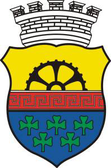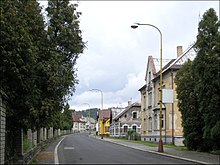Velký Šenov
| Velký Šenov | ||||
|---|---|---|---|---|
|
||||
| Basic data | ||||
| State : |
|
|||
| Region : | Ústecký kraj | |||
| District : | Děčín | |||
| Area : | 1981.4991 ha | |||
| Geographic location : | 51 ° 0 ' N , 14 ° 23' E | |||
| Height: | 357 m nm | |||
| Residents : | 1,982 (Jan 1, 2019) | |||
| Postal code : | 407 78 | |||
| License plate : | U | |||
| structure | ||||
| Status: | city | |||
| Districts: | 6th | |||
| administration | ||||
| Mayor : | Vladimír Vykoukal (Status: 2018) | |||
| Address: | Mírové náměstí 342 407 78 Velký Šenov |
|||
| Municipality number: | 562912 | |||
| Website : | www.velkysenov.cz | |||
| Location of Velký Šenov in the Děčín district | ||||

|
||||
Velký Šenov (German Groß Schönau ) is a town in the Okres Děčín in the Czech Republic .
geography
Geographical location
The city is located in northern Bohemia at 357 m above sea level. M. in the Bohemian Netherlands at the confluence of the Šenovský potok in the Vilémovský potok ( Sebnitz ) in the valley of both brooks, six km west of Šluknov ( Schluckenau ). The cadastral area is 1892 ha.
To the east rises the 543 m high Partyzánský vrch ( Botzen ), the summit of which was largely removed by a quarry , and in the southeast of the Hrazený ( Pirsken , 610 m).
Community structure
Velký Šenov consists of the districts Janovka ( Johannesberg ), Knížecí ( Fürstenwalde ), Leopoldka ( Leopoldsruh ), Malý Šenov ( Klein Schönau ), Staré Hraběcí ( Old Grafenwalde ) and Velký Šenov ( Groß Schönau ). Basic settlement units are Janovka, Knížecí, Malý Šenov, Staré Hraběcí and Velký Šenov.
The municipality is divided into the cadastral districts Knížecí, Staré Hraběcí and Velký Šenov.
Neighboring communities
Its neighboring towns are Vilémov ( Wölmsdorf ) in the west, Lipová ( Hainspach ) in the north-west, the Saxon Sohland in the north, Šluknov ( Schluckenau ) in the east, Staré Křečany ( Alt-Ehrenberg ) in the south-east and Mikulášovice ( Nixdorf ) in the south and west.
geology
Geologically and naturally, Velký Šenov is located in the Bohemian Netherlands , also known as the Schluckenauer Zipfel , the southern part of the Lusatian mountains .
history
The place arose in the 12th century during the German colonization; see: Deutsche Ostsiedlung .
The Meierhof Schönau was owned by the Hainspach estate ( Lipová u Šluknova ) since 1404 . The Reformation arrived in 1551 . In 1621 the Counter-Reformation began and in 1690 Schönau was again Roman Catholic.
The inhabitants originally lived from farming and flax spinning . The textile industry was introduced in the 18th century and metal processing in the 19th century. A steel goods factory was established and in 1884 the first electroplating factory in Austria-Hungary was built in Schönau by the industrialists Julius Josef Hille (1860–1946) and Franz Josef Müller (1853–1917). On October 4, 1907, Schönau was raised to the status of a city by Emperor Franz Joseph I and was given the name Groß Schönau . A department from the mountain association for northernmost Bohemia tried to further develop tourism in Groß Schönau and the surrounding area.
After the First World War , Groß Schönau was added to the newly created Czechoslovakia . Due to the Munich Agreement , Groß Schönau belonged to the district of Schluckenau , administrative district of Aussig , in the German Reichsgau Sudetenland from 1938 to 1945 .
The German population was forced to leave the city after 1945 during the expulsion of the Germans from Czechoslovakia .
Today trimmings , an artificial flower factory , the Severografia art print shop and a fish canning factory are located in the town . The largest local company is the strip steel and galvanization company Železárny Velký Šenov sro, which emerged from the Hille & Müller Kaltwalzwerk und Galvanik company, which has existed since 1884 .
Population development
Until 1945 Groß Schönau was predominantly settled by German Bohemia , which were expelled.
| year | Residents | Remarks |
|---|---|---|
| 1830 | 2142 | in 332 houses |
| 1900 | 3096 | (as municipality 4304) German residents |
| 1921 | 4178 | 4072 (97%) of them are Germans |
| 1930 | 3378 | 77 (2%) of them are Czechs |
| 1939 | 4459 |
| year | 1970 | 1980 | 1991 | 2001 | 2003 |
|---|---|---|---|---|---|
| Residents | 2,462 | 2,338 | 1 943 | 2,014 | 1 978 |
Culture and sights
- Church of St. Bartolomew, built in the 16th century and redesigned in baroque style around 1750
- War memorial for the city's sons who died in World War I with a sculpture created by the Austrian sculptor Ferdinand Opitz (1885–1960)
Great Schönau war memorial with the engraving "1918" and a sculpture created by Ferdinand Opitz (1885–1960)
Bronze sculpture created by the Austrian sculptor Ferdinand Opitz on the war memorial in Groß Schönau
literature
- Erhard Marschner: History of the city of Groß-Schönau in Bohemia in the Schluckenau district . Ed .: Erich Strobach, Frankfurt a. M., 1988.
traffic
Velký Šenov has a train station on the Rumburk – Sebnitz line .
Personalities
sons and daughters of the town
- Hille, tape goods industrialist in Groß-Schönau.
- Sculptor family Riedl (?)
- Augustin Bartholomäus Hille (1786–1865), Bishop of Leitmeritz, theologian and professor
- Ambros Opitz (1846–1907), theologian and politician
- Johann Hille (1852–1925), doctor, chairman of the mountain association for northernmost Bohemia
- Franz Josef Müller (industrialist) (1853–1917), trained fitter, mechanic (workshops at the University of Zurich), foreman (Löbau / Saxony), established a business for the galvanization of zinc sheets in Groß-Schönau. With Julius Josef Hille (1860–1946) founder of the sheet metal factory Hille and Müller in Groß-Schönau with branches in Porschdorf / Saxony in 1895 and in Düsseldorf in 1905 (there today: Hille & Müller GmbH). Many of his inventions have been patented in Austria and Germany. He is considered to be the founder of the nickel sheet industry in Austria-Hungary
- Julius Josef Hille (1860–1946), steel strip industrialist, initially working in the button factory of his father Johann Hille (1811–1906) in Groß-Schönau, in 1885 with Franz Josef Müller (1853–1917) founder of the sheet metal factory Hille and Müller ibid. , with branches in Saxony and Düsseldorf
- Rudolph Otto (1887–1962), painter
- Erhard Marschner (1909–1992), engineer, businessman, genealogist, employee of the Biographical Lexicon for the History of the Bohemian Countries. Ed .: Collegium Carolinum (Institute) Munich, left genealogical records of his ancestors. (Archive Sudetendeutsches Haus ), ibid.
- Hermann Strobach (1925–2018), Germanist and researcher of folk music
They lived and worked in the city
- Franz Pettrich (* 1770; † 1844), sculptor
- Friedrich August Ferdinand Pettrich (* 1798), sculptor
- Ferdinand Opitz (* 1885 Prague; † 1960 Vienna), sculptor
- Carl Robert Stein (1852–1932), entrepreneur
Web links
Individual evidence
- ↑ http://www.uir.cz/obec/562912/Velky-Senov
- ↑ Český statistický úřad - The population of the Czech municipalities as of January 1, 2019 (PDF; 7.4 MiB)
- ↑ http://www.uir.cz/casti-obce-obec/562912/Obec-Velky-Senov
- ↑ http://www.uir.cz/zsj-obec/562912/Obec-Velky-Senov
- ↑ http://www.uir.cz/katastralni-uzemi-obec/562912/Obec-Velky-Senov
- ↑ Johann Gottfried Sommer : The Kingdom of Bohemia . Volume 1: Leitmeritzer Kreis , Prague 1833, p. 267, item 12
- ^ Meyer's Large Conversational Lexicon . 6th edition, Volume 17, Leipzig and Vienna 1909, p. 947, entry Schönau , point 5) .
- ↑ http://www.genealogienetz.de/reg/SUD/orte/G.html#grosss
- ^ Rudolf Hemmerle : Sudetenland Lexikon Volume 4, page 174. Adam Kraft Verlag, 1985. ISBN 3-8083-1163-0 .
- ^ Michael Rademacher: German administrative history from the unification of the empire in 1871 to the reunification in 1990. Schluckenau district (Czech: Sluknov). (Online material for the dissertation, Osnabrück 2006).
- ↑ Czech population statistics
- ↑ (Numerous family members with short biographies and further literature in: Heribert Sturm : Biographical Lexicon for the History of the Bohemian Countries. Published on behalf of the Collegium Carolinum (Institute) , Vol. 1, R. Oldenbourg Verlag , Munich Vienna 1979, ISBN 3-486- 49491-0 , pp. 625–627)
- ↑ OPITZ Ferdinand on belvedere.at, accessed on October 21, 2016





